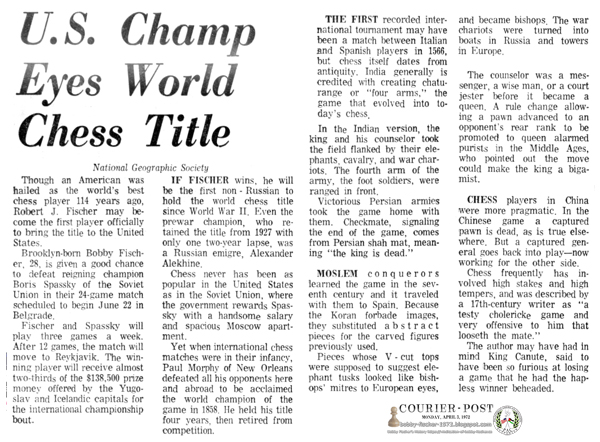Courier-Post Camden, New Jersey Monday, April 03, 1972 - Page 12
U.S. Champ Eyes World Chess Title
Though an American was hailed as the world's best chess player 114 years ago, Robert J. Fischer may become the first player officially to bring the title to the United States.
Brooklyn-born Bobby Fischer, 28, is given a good chance to defeat reigning champion Boris Spassky of the Soviet Union in their 24-game match scheduled to begin June 22 in Belgrade.
Fischer and Spassky will play three games a week. After 12 games, the match will move to Reykjavik. The winning player will receive almost two-thirds of the $138,500 prize money offered by the Yugoslav and Icelandic capitals for the international championship bout.
IF FISCHER wins, he will be the first non-Russian to hold the world chess title since World War II. Even the prewar champion, who retained the title from 1927 with only one two-year lapse, was a Russian emigre, Alexander Alekhine.
Chess never has been as popular in the United States as in the Soviet Union, where the government rewards Spassky with a handsome salary and spacious Moscow apartment.
Yet when international chess matches were in their infancy, Paul Morphy of New Orleans defeated all his opponents here and abroad to be acclaimed the world champion of the game in 1858. He held his title four years, then retired from competition.
THE FIRST recorded international tournament may have been a match between Italian and Spanish players in 1566, but chess itself dates from antiquity. India generally is credited with creating chaturange or “four arms,” the game that evolved into to-day's chess.
In the Indian version, the king and his counselor took the field flanked by their elephants, cavalry, and war chariots. The fourth arm of the army, the foot soldiers, were ranged in front.
Victorious Persian armies took the game home with them. Checkmate, signaling the end of the game, comes from Persian shah mat, mean-ing “the king is dead.”
MOSLEM conquerors learned the game in the seventh century and it traveled with them to Spain. Because the Koran forbade images, they substituted abstract pieces for the carved figures previously used. Pieces whose V - cut tops were supposed to suggest elephant tusks looked like bishops' mitres to European eyes, and became bishops. The war chariots were turned into boats in Russia and towers in Europe.
The counselor was a messenger, a wise man, or a court jester before it became a queen. A rule change allowing a pawn advanced to an opponent's rear rank to be promoted to queen alarmed purists in the Middle Ages, who pointed out the move could make the king a bigamist.
CHESS players in China were more pragmatic. In the Chinese game a captured pawn is dead, as is true elsewhere. But a captured general goes back into play—now working for the other side.
Chess frequently has involved high stakes and high tempers, and was described by a 17th-century writer as “a testy cholericke game and very offensive to him that looseth the mate.”
The author may have had in mind King Canute, said to have been so furious at losing a game that he had the hapless winner beheaded.

























